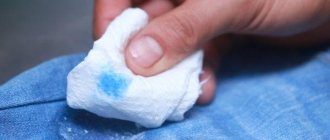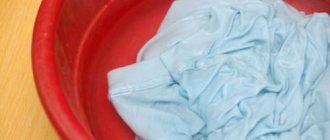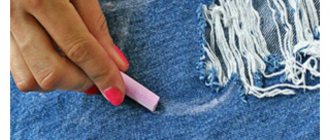When purchasing bedding, many people choose bright colors. But after the first wash they are disappointed. Beautiful colors become faded and unattractive in appearance. Sleeping on such a product is unpleasant and harmful - allergies may occur. This happens if the product is made from low quality fabrics or is fake. Problems can be avoided if you follow some rules. Let's try to figure it out.
How to check color fastness?
Have you purchased a new bright blouse and don’t know whether it fades or not? To avoid any unpleasant surprises when washing your new item, arrange a kind of quality testing for it in one of 3 possible ways.
Option 1
- Wet a small piece of clothing.
- Iron it through the paper.
- If there are stains on the paper, it means the fabric may fade.
- Conclusion - wash it separately from other things.
Option 2
- Cut a small piece of fabric from the wrong side, near the seam, so that it is not noticeable.
- Soak it in ammonia.
- Leave for 10 minutes.
- Rinse.
- Check to see if the color has changed.
On a note! Do not try to immerse the entire thing in ammonia. When buying an item, you can often see that a piece of the same color is sewn on the reverse side - take a piece from it. It’s even better if the clothes are sewn in a tailor’s shop: you’ll probably have scraps of fabric left over—and practice on them.
Option 3
- Pour warm water into a bowl.
- Add some powder.
- Soak the clothes for 10-15 minutes.
- Wrap in white cotton fabric.
- Wring it out and check for stains.
- Look at the water in the container to see if it has turned the appropriate color.
- If traces remain, wash the item in the future without mixing it with other items.
On a note! If you don't have much time to do this check, soak a small piece of clothing in very hot water and apply it to a dry white cloth. The result will not be long in coming, but proceed with caution - high-temperature water can ruin the item.
Ironing
In most cases, bedding sets do not need to be ironed, since ironed fabric absorbs moisture less well. But for small children or sick people this procedure is mandatory.
Natural fabric smoothes out easier and faster if it is still slightly damp. Therefore, it is recommended to remove the laundry from the line not completely dry. If the pillowcases and duvet covers are completely dry, during ironing they are sprayed with water or ironed with steam. Natural silk sets are ironed only from the inside out.
How to properly wash things that fade?
In order not to damage your clothes or spoil an expensive or simply beautiful thing, follow the following recommendations:
- Be sure to sort your clothes before washing. Things painted in warm colors (red, burgundy, yellow, orange) should never be mixed with those that have cool shades (green, blue, purple, cyan). Wash black fabric items separately.
- Use exclusively powders for colored fabrics or special gels such as “Perwoll”.
- Wash fading items at a temperature no higher than 30-40 degrees. In an automatic machine, select the mode depending on the type of fabric.
- When washing by hand, put the powder in water, stir and whisk until foam forms. Only then put the clothes on - you need the detergent to completely dissolve, otherwise its grains will discolor areas of the fabric.
- It is forbidden to use soap and soda for washing - they can change the color of the product and disrupt its structure.
- Do not use bleaches for colored fabrics.
- Do not overuse stain removers. Try to remove dirt using available substances (vinegar, lemon, a weak solution of ammonia).
- After washing, rinse items in cool water with vinegar: it will fix and at the same time refresh the color, and the fabric itself will become softer.
Why does it shed?
First of all, it all depends on the painting method. How to fix the paint? The design is applied directly to the material or the fabric is woven from already dyed threads. Depending on the painting method, the canvas will lose brightness faster or slower:
- Long-term color durability is best ensured by dyeing the yarn itself before you begin to weave it. When using this method, textiles will not only retain bright colors for a long time, but will also be softer, more comfortable and pleasant to the touch.
- When applying paints to fabric, a rich, bright pattern is obtained. It is important that the pigments for coloring are of high quality, otherwise the bed linen will fade or even stain your body while you sleep.
Important! The latter method is used in the production of bedroom textiles with a three-dimensional 3D pattern.
But what if the purchase was not of the best quality? How to wash bed linen without fading? To preserve the appearance of your favorite set, you need to follow some operating rules.
How to wash faded items?
Depending on the type of fabric, to fix or refresh color, remove stains, wash, rinse and dry items, you will need:
- water;
- gel for delicate fabrics (“Perwoll”);
- salt;
- 9% vinegar solution;
- turpentine;
- ammonia;
- glycerol;
- mustard powder;
- lemon;
- bran;
- alum;
- tea leaves;
- paper;
- white cotton fabric (sheet, towel);
- bowl or basin;
- iron;
- washing machine.
Important! If you didn't take care of the shedding item and it got into the washing machine tank in some miraculous way, we will help you correct this situation. Follow the link right now and you will find out.
There are 3 main stages of caring for such fabrics:
- soaking in cold water to pre-fix the color;
- washing separately from all other products;
- rinsing with fixation using special means.
To prevent washing from harming things, do it using one of the following methods.
Method 1
Use salt as a fabric color fixer:
- Pour cold water into the container.
- Add regular table salt in the proportion - 1 tbsp. for 1 liter of water.
- Mix thoroughly.
- Soak the colored item.
- Wait 1 hour.
- Wash with powder by hand or machine.
- Rinse well.
- Dry.
- Iron on the wrong side.
On a note! The method is suitable for things in red, green, blue and black colors - as a rule, they shed most often.
Method 2
Use vinegar to keep things bright:
- Fill a bowl with 8-10 liters of cold water.
- Add 3 tbsp. 9% vinegar solution.
- Immerse clothing in the solution.
- Leave for 10-15 minutes.
- Drain and wash as usual.
- Rinse in lukewarm water, then a couple of times in cold water.
- Squeeze lightly.
- Dry things in the fresh air.
On a note! Thorough rinsing and airing are necessary in order to get rid of the specific sour odor of vinegar essence.
Method 3
Cotton items will not fade if you do this:
- Pour 2 liters of cold water.
- Add 1 tbsp. turpentine.
- Soak the product for 10 minutes.
- Drain the solution.
- Wash clothes in cool water (30 degrees) with powder whipped until foamy.
- Rinse: 1st time - with the addition of 5-10 drops of vinegar, then - in clean water, at the rate of 1 tbsp. l. for 1 liter of water
- Dry thoroughly in fresh air.
On a note! The method is especially effective for washing blue, pink and yellow items. You can take more water, the main thing is to maintain the proportion.
Method 4
Capricious items made from mohair will become soft if you use a separate recipe:
- Pour lukewarm water into a bowl.
- Stir a little gel for delicate fabrics into it.
- Soak things for 10-15 minutes.
- Drain the solution and collect clean water.
- Add 2-3 tbsp per 1 liter. glycerin.
- Pour in the required amount of detergent.
- Wash carefully.
- Rinse.
- Gently squeeze without twisting.
- Dry the items horizontally, laying them on a clean cloth
Important! In another article on our site, we gave even more tips that will help you firmly. Hurry up to use this information so that any item from your wardrobe will always be in order and ready for your appearance!
- For wool clothes, add mustard powder when washing.
- Wash silk products in water where the bran has been previously soaked.
- After rinsing, soak beige, cream or brown clothes in the tea infusion solution for several minutes; depending on the intensity of the color, it should be more or less strong.
- If the pattern on green or black fabric has faded, try refreshing the color by rinsing in an alum solution.
- To remove white stains from deodorant on dark clothes, gently moisten the stained areas with vinegar applied to a cotton pad, then wash the item.
- Wring out the fabrics without twisting them; it is advisable to wrap them in a clean white sheet.
- Dry items in a well-ventilated, shaded place. Remember that direct sunlight will cause bright colors to fade.
- For the same reason, turn everything inside out.
- Dry delicate items and fabrics of combined colors in a horizontal position, laying them out on a towel.
- Iron items that may fade only with an iron with a thermostat.
Important! Maybe,
What to do before washing
So, let's take a closer look at what to do before washing colored laundry in order to avoid shedding. Before you put all your clothes into the washing drum, you need to do some preparatory steps:
Before putting it in the wash, do a shedding test. There is a considerable level of shedding in green and red items. If you don't know how the clothes behave, then don't put them in the machine;
Linen is sorted by shade. This will prevent light-colored clothing from staining. Whites can only be washed with whites. Orange, pink and yellow colors are perfectly acceptable to wear with light brown clothes. Black clothes can be washed with gray and dark blue. Place colorful things separately from others. And wash green, blue and blue together; it is necessary to minimize fiber friction, which causes microdamage to the threads. And this in turn causes clothing to shed. This is especially true for cotton. Over time, such clothes fade. So, it is important to wash light fabrics separately from heavy ones. Jackets, jeans, etc. wash with zippers and buttons fastened. Turn them inside out to eliminate friction on the outer fibers;
It is important to properly prepare your laundry for washing. Remember that this is one of the key stages.
set a gentle washing program, which will cause less curling of clothes; It is easy to carry out a shedding test before washing. Place the item in water and soapy water for a quarter of an hour. If your clothes are shedding, you will notice discoloration in the water.
Rules for washing fadeable items
To prevent things from fading, you need to follow the basic washing rules. They are quite simple:
First of all, set the correct temperature. It is worth washing in cool water, except for towels and bed linen. Today, detergents perfectly remove dirt even in water at 40 degrees. Washing can be done in cold, but not ice water; In addition, do not wash in water with soda and vinegar. More often than not, this not only does not work, but also degrades the quality of the clothing. The problem is that not all dyes are fixed with vinegar. It is better to use it to eliminate odor. It is used to rinse tracksuits, socks, kitchen towels; In addition, a special napkin is placed in the drum of the washing machine with things of different colors. It detects the presence of dyes in the water, so it quickly picks up the dye during washing. This way you can keep your favorite clothes;
If the item has faded a lot during the shedding test, then do not machine wash it; To ensure delicate spinning, so that things do not curl too much, washing covers are used. If you need to wash your jeans, then excessive twisting causes white stripes, so the cover will be of considerable benefit;
Never use untested products on new things. This can cause disastrous results.
choose the right detergent. For white and colored fabrics there is. Liquid powder for colored laundry will help maintain a beautiful shade longer.
To avoid washing out the colors from clothes, do not soak them before washing, or wash them with soap. To remove stains, use a liquid stain remover. They treat matter more carefully.
Washing rules
Bedroom textiles should be washed separately from other clothes, observing the temperature regime. If bed linen loses its color and the pattern fades, then it must be washed according to these rules:
- Observe the thermal regime - the maximum temperature is 60 degrees, but it is still recommended to wash at 40 degrees.
- Use special detergents and gels for colored fabrics to help preserve the color.
- Place special napkins for washing in the drum of the washing machine. Their fibers will absorb the pigment, preventing other things from staining.
- Add salt or vinegar to the powder compartment. But after such a wash, it is imperative to run the machine at idle speed (washing without laundry) so that the device does not malfunction.
However, washing bed linen with folk remedies is controversial advice, because vinegar does not fix many paints, and makes the fabric itself hard.
Important! It is better to use vinegar water to wash items from which you need to remove unpleasant odors, such as kitchen towels or sports uniforms.
And to prevent bed linen from fading during washing, there are several other ways.
Methods for washing colored laundry
Remember that faded items can only be washed individually. But it’s important to preserve the color for a long time, so let’s look at ways to wash clothes that will help you cope with this task:
First option.
If you know that the material sheds a little, then try to get rid of the excess color. They do it like this:
the item is soaked in heated water; then rinse with tap water; re-soak for 40 minutes; if less paint comes out, rinse again under the tap; Soaking is repeated until excess color is washed off; wash the item in the washing machine with added powder.
Second option.
If the material continues to shed, you will have to resort to other means. Salt is a natural material; it can “hold back” color and at the same time cleanse the fibers of dirt. For effective results you need to follow these steps:
prepare a bowl of water slightly warmer than room temperature; pour 1 tbsp into it. salt and a handful of powder; leave the item to soak for half an hour; wash by hand; rinse under the tap.
This option is only suitable for one-color items. It is not recommended to wash colorful clothes this way.
Third option.
This method requires the addition of vinegar. This acid is capable of fixing paint; after using it, clothes will shed less in the future. Do the following:
prepare a deep basin; add water with a maximum temperature of 40 degrees and add powder; soak the clothes for a third of an hour, then wash them; make a solution of vinegar: 5 spoons for 7 liters of water; rinse the item in this solution; leave to dry without squeezing.
Fourth option.
This method also requires the use of vinegar. Only in this case it is necessary not to rinse, but to wash. The process is:
pour 4 liters of heated water into a deep bowl; 2 tablespoons of powder and 3 tablespoons of vinegar are poured into it; put the clothes into the solution and rub them a little; now rinse in cold water under the tap; hang without squeezing.
There are many washing methods to preserve color and remove excess color, but it is important to use them with caution.
It is also important to follow the rules for rinsing things that shed. The duration of color retention depends on this:
leave clothes at the bottom of the bath after washing; pour cold water from the shower over it; turn it over to the other side and do the same manipulations; now turn it out and repeat again; Reduce the water temperature and pour over the clothes again.
Washing colored clothes in a washing machine
So, let's look step by step at how to wash clothes that are too dyed in a washing machine:
Before putting it into the drum, the item should be briefly left in a vinegar solution in warm water. Solution proportions: 4 liters of water, 2 tablespoons of powder and 3 tablespoons of vinegar; set a washing program with a water temperature below 40 degrees; Before washing, be sure to turn things inside out; turn off the spin; hang clothes without wringing, but simply straighten them with your hands; Dry also inside out.
Additional rules:
never use soda to treat things prone to color loss; Certain types of materials are prohibited from being machine washed; Before washing for the first time, study the information on the label. Companies often specify rules of care.
Are there any secrets in care?
The main secret is to wash according to the type of fabric of the set. And despite all the “indestructibility” of the material (this is how housewives characterize calico), follow the care recommendations given by the manufacturer. If previously fabrics could be boiled and bleached with chlorine with impunity, now this is impossible, at least not with all materials. High temperatures destroy the dye and fibers of cotton fabrics (calico, poplin, percale) and promote shrinkage. But satin requires a particularly delicate attitude.
- Do not place satin jacquard in the same drum with textiles that contain sharp corners and edges, this can lead to snags. In general, it is better to wash all satin on a delicate cycle.
- Flax can be boiled and even bleached (but without chlorine), this will only make it better.
- Synthetic fibers also deform at high temperatures, so do not set the mode to temperatures above 60°C.
And, of course, remove stains before washing, otherwise they can only penetrate deeper into the bed linen.
Rules for choosing clothes
To avoid the problem of washing faded items, you must follow the rules for choosing clothes when purchasing. Dense fabrics shed less; polyester is rarely dyed; it can retain the shade for a long time. Shedding resistant jersey, smooth knit, high quality cotton.
Often, even by touching, it is easy to tell whether clothes are fading. If you slightly wrinkle the fabric, it will “crunch” if there is excess paint in it. Here you can be sure that your clothes will fade when machine washed. So use manual first.
The right choice of clothes and fabrics will eliminate the problem of faded items.
The label will also tell you a lot of information. But not all manufacturers put the labels “wash in cold water” and “wash on the wrong side” on their labels. These inscriptions indicate the instability of the paint. But this does not mean that such things are prohibited from buying. Just follow the washing rules.
Remember that cost is not an indicator of color quality. Even expensive silk retains its shade worse than cheap polyester and other synthetics.
January 27, 2014, 12:48 pm
It can be very disappointing when new clothes, during the first wash, not only lose their appearance and color, but also spoil other things. If you know how to wash faded items correctly, there will be less disappointment. The rules are simple and there are very few of them.
Rules for choosing bed linen
If you know how to choose the right things, you can avoid many problems later. For example, linen made from thick calico sheds less, just like cotton.
If you are not sure whether the bed linen will be dyed, then remember the fabric in your hand - a characteristic “crunch” will signal that there is excess dye in it. When buying such linen, be aware that you will first have to wash it by hand, rinsing the pigments from the surface of the material. This should always be done before washing new bed linen so that it does not fade in the drum of the washing machine.
Important! Many are sure that a high price will automatically eliminate problems with shedding, but this is not the case. Often the prices are inflated, and having bought an expensive bedroom set with rich and bright pictures, you cannot be sure that this is not a cheap fake, the picture will come off after the first wash.
Basic rules for washing colored items
Before washing, clothes must be sorted:
- white - separate from everything;
- black, gray, blue;
- from yellow and orange to red and pink; can be washed with light brown items;
- blue, blue, green;
- motley.
Separation by material
Clothes made from different materials require different washing powders or liquids. Linen can be washed with cotton, silk with synthetics, wool separately. Separate washing should also be done for jeans, which not only usually fade, but can also be damaged by zippers and rivets on more delicate items.
Pre-check
New items need to be checked for color fastness. The easiest way to do this is to use an iron: lightly wet the item in an inconspicuous place, cover with a white napkin and press with a hot iron. Shedding fabrics will certainly appear as colored streaks and spots.
Fixing paint
If you find that your clothes are fading, you can try fixing the dye to the fabric. To do this, you need to soak the item for 1 hour in salt water at room temperature. For the solution, just take half a glass of salt in a bucket of water. Instead of salt, you can make a vinegar solution: ¼ cup of table vinegar per bucket of water. Vinegar should also be added to the rinse water. Dye on cotton fabrics is fixed in a turpentine solution: 50 ml per 5 liters of water, soak for 30 minutes. Don't worry about the smell, everything will wash and rinse off.
No bleach
To prevent things from fading, you need to use only universal products or those specifically designed for colored fabrics. Before washing faded items, you should always look at what is written on the clothing label.
Take note
- Before washing, it is better to turn things inside out and fasten all zippers and buttons.
- You need to wash in almost cold water, up to 30°C. And no soaking in detergent before washing!
- We select only delicate mode, with minimal spin. If washing faded items by hand, do not twist the faded item too much or rub it too much.
Modern methods of dyeing fabrics most often provide fairly durable dyeing. If the item sheds a lot, then it is most likely due to the poor quality of the paint. Try returning the defective product to the store, or contact the Consumer Rights Protection Society. Low-quality paint can cause irritation and allergies, and therefore poses some danger to sensitive skin.
This applies to jeans to a much lesser extent, since some of the dye often comes out of denim during the first few washes. As a rule, already by the third or fourth time the water will acquire only a faint tint. If you wash your jeans inside out and with all zippers or buttons fastened, the rich color will last longer. It is better not to wring jeans too hard, as this may cause light streaks to appear on the fabric.
This is a serious matter; not every housewife decides to buy a bright wardrobe item due to loss of color. You shouldn’t be afraid of this; knowing some tricks of the procedure, you can clean things without fear of loss of color. Bright clothes will bring positivity and good mood into our lives; the rich color will delight both the eyes and the soul.
How to detect shedding items?
Before washing new or brightly colored clothes, you need to find out whether they fade or not. Carrying out this procedure will help protect the product itself from loss of color, and other wardrobe items from acquiring foreign colors. How is something that sheds detected? This is done in several ways:
- Take warm water into a basin, soak a small area of the new item in the liquid and squeeze it out well. Next, lay a white cloth or paper towel on the ironing board and iron the wetted and wrung-out area of the garment. Traces of paint remaining on paper or fabric indicate that the dye has not adhered well to the fibers. An additional procedure should be carried out to help the color preserve. This product must be washed only by hand in a separate basin and only in warm water.
- From the inside, they find a scrap for testing or cut off a small piece from the seam of the product. Ammonia is poured into the container and the shred is soaked in it for 10 minutes. After the time has passed, rinse well, wring out and apply to a piece of clothing. If the item sheds, the cut piece will be significantly different.
- A soap solution test will help identify a new shedding item. Add laundry soap or any detergent to a bowl of warm water, and place your purchase there. After 10-15 minutes, take it out of the basin and let the water drain a little. If the water is not colored, then for further actions you will need a light, plain or white fabric. Having wrapped the product in it, they begin spinning. If after the main removal of moisture the fabric is not colored, then the item of clothing is not subject to shedding. If the fabric fades, this will be indicated by marks on the section through which it was wrung out. Colored water will give away a product that sheds heavily.
Depending on the results of the test, other procedures are carried out; for those that fade, the color must first be fixed, and the well-adhering dye is simply washed off in the usual way.
Important! Even if the items are not prone to shedding, it is worth washing whites separately from colored and dark ones. Dark clothes can be washed in the drum with brown and dark blue, red with orange and pink, blue with green and light blue.
Proper washing of faded items
How to wash items on which the paint has not completely set? It’s easier to do this than it seems; it’s enough to know some secrets of the procedure and pre-fix the color.
Washing fading fabrics begins with preserving the color; this can be done in several ways:
- Kitchen salt is diluted in water; the solution is prepared at the rate of a tablespoon of the substance for each liter of water. To be effective, the product is left in this liquid for an hour, then rinsed and washed.
- A composition of water and table vinegar will have no less effect; for this, dilute 3-4 tablespoons of the product in 8-10 liters of water. Soaking lasts only 10-15 minutes, otherwise the fibers may deteriorate.
It is worth understanding that it is necessary to prepare solutions to preserve color and soak them before molting only in cool water. Warm liquid will cause color loss.
Stains are removed only with weak stain removers and only after preliminary testing. It is prohibited to use chlorine-containing substances, otherwise you will have to say goodbye to color forever.
How to wash wardrobe items that are prone to color loss? It is better to do this by hand, in cool water, using liquid detergent. When rinsing, add a little vinegar to the last water, it will help preserve the color.
Machine washing is carried out as follows:
- The washing mode is set in accordance with the quality of the fibers.
- The maximum temperature should not exceed 30 degrees.
- Spin is set to minimum.
- Liquid detergent is poured into the powder tray.
- They start the car.
At the end of the cycle, the product is removed from the drum; if desired, another rinse in water with vinegar or a weak saline solution is allowed.
To preserve products with bright colors, you must use a product only marked Color; for white, look for the inscription White. Universal ones will not be able to maintain the brightness of the colors, and white linen will soon turn gray.
We found out how to wash faded items, and it turned out to be nothing complicated. It is enough to fix the color and strictly adhere to the temperature regime, that’s all the secrets.
- How to properly wash faded items in a washing machine
It becomes terribly unpleasant when a new thing completely loses its color and becomes nondescript. What to do to prevent things from being painted? How to wash bright clothes so that they do not deteriorate or lose their color? In this article, we will provide you with all the information on preserving the color of your favorite item.
How to wash it correctly for the first time?
You've probably noticed that the PBC you just bought is a little hard, as if starched? That’s right, this is a production treatment to remove dust, which includes starch. It also includes dye particles.
Removing production processing is not difficult. It’s hard to even call it washing – it’s more like rinsing.
- Turn the duvet cover and pillowcases inside out, shake out any remaining dust;
- set the most gentle mode on the washing machine;
- add half the amount of detergent and run the cycle. Dry and iron as usual
By the way, it’s even better to replace the gel with laundry wipes.
As you can see, nothing complicated. This way you make%D0%B1%D0%B5%D0%BB%D1%8C%D0%B5″>https://ivselena.ru/catalog/postelnoe-bele/»>the laundry softer, get rid of excess paint, and most importantly - from the unpleasant smell of clothing production.
How to wash without dyeing things?
This rule is always worth remembering! Fabrics that are dyed must be washed separately. There should be a delicate approach to it, because it is important to preserve its shade. Below we will list all the ways to preserve the color of fabric using the above means.
Method 1
If the fabric does not stain much, then try to get rid of excess paint. Do the following:
- Soak the item in warm water;
- Rinse under running water;
- Then re-soak in water for 40 minutes;
- If you wear less makeup, rinse under the tap;
- Soak until excess paint is washed off;
- Wash with powder in a machine (observing the temperature/washing mode).
Method 2
Use this product if the fabric continues to stain. Salt can perfectly retain color and remove dirt. To achieve the desired effect, follow the instructions:
- Fill the basin with warm, but not hot water;
- Pour a glass of salt and a handful of washing powder into it;
- Leave the item in this solution for 30 minutes;
- Then wash the item by hand;
- Rinse under running water.
Important!
Use this method only for plain colored fabrics.
Method 3
Now let's take vinegar. To make the item fade less, you need to fix the color, acetic acid will help us with this.
- Pour water (30-40 degrees) into any deep container and add a little powder;
- Place the item in the solution and leave for 20 minutes;
- Wash;
- Dilute vinegar in a bucket of water - 5 tbsp. vinegar;
- Rinse the item in the vinegar solution;
- Let the item dry without twisting it.
Method 4
Consider another use for vinegar. You need to wash the item in it and not rinse it. Proceed like this:
- Pour 4 liters of warm water into a deep basin;
- Pour 2 tbsp into it. washing powder;
- Then pour 3 tablespoons of vinegar there;
- Place the item in the resulting solution;
- Rub lightly;
- Rinse in warm running water;
- Hang to dry without twisting.
How to properly wash faded items in a washing machine?
- Before you start washing in the machine, the item should be soaked in a vinegar solution, pour a little powder into warm water, add vinegar to it in the proportion of 4 liters/2 tbsp/3 tbsp;
- The washing mode should be selected with a temperature below 40 degrees;
- Before putting it into the machine, turn the clothes inside out;
- You should also remove the spin mode;
- After washing in the machine, dry the item from the wrong side without twisting, just smooth it with your hands.
- There is no need to treat faded fabrics with baking soda.
- Not all items can be machine washed.
- Pay attention to labels before washing brightly colored items for the first time. They contain all the information on caring for the fabric.
- How to find out that an item is fading; the easiest way to find out whether an item is changing color or not is to carefully wipe a small area on the clothing with a damp cloth. If the napkin gets stained, then decide whether to take such a thing or not.
Preserving a bright shade is quite simple, you just need to choose the right method and strictly follow all the instructions. The main thing to remember is that if a thing is painted excessively, then it is the fault of the manufacturers who simply skimped on its quality.
Why are fabrics dyed?
Paint is applied in two ways:
- dye the fibers before production begins;
- The design is applied to the material by printing.
In the first case, you get a plain bed linen, in the second - a clear, bright pattern. Plain PCBs are practically not painted, but with a pattern they can be painted. By the way, PCBs with a 3D effect shed the most, and this is partly why they have lost popularity.
And you can determine whether bed linen will be “problematic” before purchasing. To do this, during inspection, wet your fingers a little and squeeze the fabric. If there is a bright, clear mark on your fingers, there may be problems with the textiles. No - there won't be any problems. A small print is a production dust treatment that contains paint particles.
It is precisely in order to remove the CPB treatment that it is recommended to wash it for the first time.











